The 39 Steps
Adapted by Patrick Barlow
Based on the Novel by John Buchan
From the Movie by Alfred Hitchcock
San Francisco Playhouse
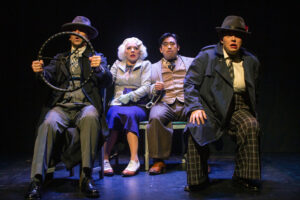
In Patrick Barlow’s 2005 theatrical adaptation of the 1915 John Buchan novel and the 1935 Alfred Hitchcock film version of The 39 Steps, the suspense and dark natures of Hitchcock’s enduring thriller – ranked in 1999 by the British Film Institute as the fourth best, 20th century film – are turned upside down through a ridiculously fast-paced, spontaneous-feeling script in which four actors play upwards of 150 roles. Turning the nail-biter espionage film into a rip-roaringly funny, fast-action play, Barlow never lets us forget the source that he mimics with his lacing throughout his script hilarious references to other Hitchcock favorites of the audience. Along with a 2015 New York revival, subsequent regional productions have swept through this country by the dozens; but with the script now in the hands of Director Susi Damilano, other excellent productions this reviewer has seen are only a teaser for the over-the-top, rib-tickling rollercoaster ride of laughs to be had at San Francisco Playhouse – a staging with a ridiculously talented quartet of highly versatile thespians guaranteed to leave the sides of exiting audience members hurting from so much constant gaffawing.
The basic storyline has stayed the same throughout its evolutionary path from the page to the stage. On an August night in 1930, a rather debonair London chap at the theatre, Richard Hannay, finds himself suddenly lured from his box seat to his own apartment by a sexy, mysterious woman with heavy German accent, Annabelle Schmidt. Before she soon becomes a stiff corpse with a knife in her back, he learns from her enough to understand that she is on a mission as a counterspy to keep important, national security information from leaving England. With her dying breath, she sends him on a harried chase to Scotland to find and interrupt “the thirty-nine steps” (code name we will learn for a spy chain, most assuredly connected to the rising Nazi regime of Germany). On that quest, Hannay is also on the run from local police and Scotland Yard with his picture and accusing headlines plastering every newspaper for a murder he did not commit.
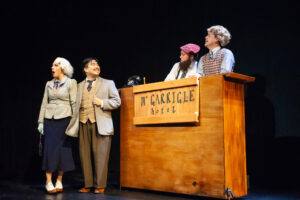
While all the basics of the original Hitchcock movie are retained in Patrick Barlow’s adaptation, there is much more to enjoy than just the film master’s black-and-white play of shadows and light (although the frightfully fabulous lighting design of Derek Duarte makes great use of large, looming shadows in deference to the great Hitchcock). Life-and-death chases through fog-covered bogs on the Scottish Highlands, trips on bumpy country roads and swaying trains, and escapes from chasing cops and a diving airplane are all accomplished through the ingenuity of what appears as actor improvisation but is actually a highly conceived ballet of arms, legs, and bodies moving at lightning speed in all directions. While the actor playing the ever-serious-to-his-mission Richard is constant throughout the play, two actors – one male, one female – continuously switch hats, coats, voices, genders, stances, and demeanors to take on roles as police, newsboys, villains, country bumpkins, underwear salesmen, and dozens of other quirky roles of varied nationalities and accents. The remaining member of the troupe, a female, plays an enticing but doomed counterspy, a young farm wife with roaming eyes of lust and a wretchedly pious husband, and a train passenger who finds herself eventually handcuffed and on the run with a man she has recognized and notified authorities as the accused London murderer (our very own Richard Hannay).
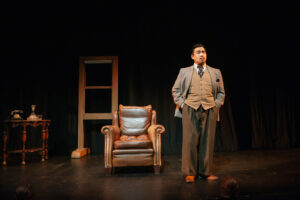
“I was bored, no not bored, tired of life” is the introduction that Richard Hannay provides to us upfront; and even though all of that is about to change, Phil Wong wonderfully retains a minimalistic, often underplayed set of expressions and reactions even as chaos is erupting all around his thirty-seven-year-old character. Thick eyebrows that speak volumes, a chin that protrudes to express a point of view, and a mouth that sometimes seems not to move out of neutral position for minutes on end are just a few of Phil Wong’s many ways of adding hilarity to a man who is otherwise hanging onto the outside of a speeding train, jumping from a bridge (actually a board between two ladders) into a river, or smashing through a window in his latest escape from chasing authorities.
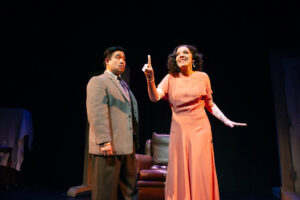
Maggie Mason shows off her comic genius time and again as she absolutely excels in three, key roles of the women Hannay encounters. Her doomed Annabelle Schmidt could easily be confused as the star of a silent movie as each look and move is to the hilt dramatic and with a slight pause to ensure the camera catches the intended effect. A young Margaret stuck in the Scottish Highlands on a farm with a husband much older and uglier than she hilariously bats eyelashes and flirts unabashedly with the hiding Hannay, stroking with erotic intensity a table’s legs while staring at Hannay during her husband’s much-too-long grace at dinnertime. And as Pamela, a woman who finds herself handcuffed to the escaping Hannay and who adds to her own troubles by continually ratting on him to the authorities, Maggie Mason is at times a Lucille Ball in her antics, looks, and physical dexterity – especially as she tries to take off her stockings with a wide-eyed Hannay whose hand is cuffed to hers and is reaching into regions unmentionable.
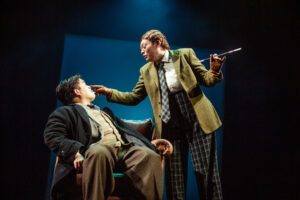
As they bring several score of city and countryside good and bad characters to life before our eyes, Renee Rogoff and Greg Ayers draw time and again the evening’s biggest laughs. With great use of Alice Ruiz’s ingenuous design of quick-change coats, cloaks, hats, and wigs, they switch ages, nationalities, economic classes, professions, and genders at the open-and-close of a door, a twist in and out of a garment’s sleeve, a quick duck behind a counter, or – more often than not – right before our eyes without blinking an eye. In one sequence when the two are on the train with Richard, the entire audience erupts in non-stop giggles as they madly switch hats to go back and forth, over and again from policeman to conductor to paper boy to male passenger to female passenger – often changing voice, facial expressions, and accents mid-sentence. Like Maggie Mason, they too have profited from the wide ranged dialect coaching by Kimberly Mohne Hill to employ a number of dialects with great ease and effect, from high English airs to country Scottish slurs to harsh German clicks.

But for all the talents of this incredible cast, so much of the night’s riotous humor is due to the hundreds of small and large decisions by the evening’s director extraordinaire, Susi Damilano. Even before her husband and Artistic Director Bill English can arrive onstage for his usual, opening night welcome, the play begins, only to be stopped by the miffed AD, with the halt of the opening scene looking much like someone just ripped the cord from the auditorium’s movie projector. Subsequent scenes continue to be drop-dead funny due to directorial prowess – scenes like a chase on the outside and on the top of a fast-moving train that is actually only several storage trunks (part of Heather Kenyon’s highly flexible, quick-to-appear/disappear scenic design), like two sets of arms and legs hopelessly entangled seemingly forever around a fence, and like the sudden appearance/disappearance of two spies at a corner’s street light each time Richard peeks out his apartment’s window. Actors time and again hilariously freeze or repeatedly re-do actions, employ the antics of clowns or mimes, and simply move at great speed in all directions in a seamless flow of shifts and changes – all a combined collaboration of actors and director to be celebrated.
Finally, well-deserved kudos go to Sound Designer Dan Alvaro Holland who peppers the evening’s feast of fun and frolic with the sound effects, musical chords, and quick interludes of song that accompany over-dramatic facial expressions, the latest chase, or the next moment of near disaster for our escaping hero. Whether a virgin to The 39 Steps or seeing the Hitchcock thriller turned the Barlow farce for the fifth time as I, the sounds and sights, the surprises and silliness, and the suspense and spoof of San Francisco Playhouse’s current production make this latest 39 a definite must-see.
Rating: 5 E, MUST-SEE
A Theatre Eddys Best Bet Production
The 39 Steps continues through April 20, 2024, in production by San Francisco Playhouse, 450 Post Street, San Francisco. Tickets are available at www.sfplayhouse.org or by calling the box office at 415-677-9596 Monday – Friday, 1:00 – 6:00 p.m.
Photo Credits: Jessica Palopoli
